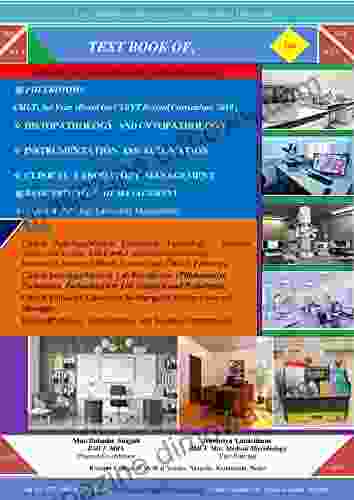Unveiling the World of Phlebotomy, Histopathology, and Cytopathology: A Comprehensive Guide to Instrumentation and Automation in Clinical Settings

The field of healthcare technology is rapidly evolving, and the disciplines of phlebotomy, histopathology, and cytopathology are no exception. These specialized areas play a crucial role in the diagnosis and treatment of diseases by providing accurate and timely information about the patient's condition.
In this comprehensive guide, we will delve into the world of phlebotomy, histopathology, and cytopathology, exploring the latest advancements in instrumentation and automation that are revolutionizing these fields. We will discuss the principles, techniques, and applications of various instruments and automated systems, providing readers with a thorough understanding of their capabilities and benefits.
4.5 out of 5
| Language | : | English |
| File size | : | 53173 KB |
| Text-to-Speech | : | Enabled |
| Screen Reader | : | Supported |
| Enhanced typesetting | : | Enabled |
| Word Wise | : | Enabled |
| Print length | : | 855 pages |
| Lending | : | Enabled |
| Paperback | : | 110 pages |
| Item Weight | : | 7.8 ounces |
| Dimensions | : | 6 x 0.28 x 9 inches |
Phlebotomy: The Art and Science of Blood Collection
Phlebotomy is the process of collecting blood from a vein, usually for the purpose of medical testing. It is a critical procedure that requires skill, precision, and a thorough understanding of human anatomy. The development of automated blood collection systems has significantly improved the efficiency and accuracy of phlebotomy, making it safer and more convenient for patients.
Principles and Techniques of Phlebotomy
The principles of phlebotomy involve selecting the appropriate vein, inserting the needle, and withdrawing blood without causing damage to the vessel or surrounding tissue. Various techniques are used to perform phlebotomy, including:
- Venipuncture: The most common technique, involving the direct puncture of a vein with a needle.
- Skin puncture: Used for collecting small samples of blood from the fingertip or earlobe.
- Arterial puncture: A more invasive technique used to collect blood from an artery.
Automated Blood Collection Systems
Automated blood collection systems offer several advantages over manual phlebotomy, including:
- Accuracy: Automated systems minimize the risk of errors by using precise measurements and automated controls.
- Efficiency: Automated systems can collect multiple samples simultaneously, significantly reducing the time required for phlebotomy.
- Comfort: Automated systems cause less pain and discomfort for patients compared to manual phlebotomy.
- Safety: Automated systems reduce the risk of needle sticks and other injuries to both patients and healthcare professionals.
Histopathology: Unraveling the Mysteries of Tissues
Histopathology is the branch of pathology that deals with the microscopic examination of tissues to diagnose and study diseases. It involves the preparation, staining, and analysis of tissue specimens to identify abnormalities and assess the severity of conditions such as cancer, infections, and autoimmune disFree Downloads.
Principles and Techniques of Histopathology
The principles of histopathology involve the following steps:
- Tissue preparation: Tissues are fixed, embedded in paraffin wax, and cut into thin sections.
- Staining: Sections are stained with dyes to highlight specific cellular components and structures.
- Microscopic examination: Stained sections are examined under a microscope to identify abnormalities in cell morphology, tissue architecture, and the presence of microorganisms.
Instrumentation and Automation in Histopathology
Advanced instrumentation and automated systems have revolutionized histopathology, enabling faster, more accurate, and more efficient tissue analysis. Key technologies include:
- Tissue processors: Automated machines that perform the steps of tissue preparation, including fixation, embedding, and cutting.
- Staining systems: Automated systems that stain tissue sections with precision and consistency.
- Digital pathology: Computer-based systems that digitize tissue slides and enable remote viewing, analysis, and archiving.
- Immunohistochemistry: Automated systems that detect specific proteins in tissue sections using antibodies.
Cytopathology: Exploring Cells for Diagnostic Clues
Cytopathology is the branch of pathology that focuses on the examination of individual cells to diagnose and study diseases. Cytopathologists analyze cells collected from various body fluids, such as urine, sputum, and pleural fluid, as well as from scrapings and biopsies of tissues.
Principles and Techniques of Cytopathology
Cytopathological techniques involve:
- Cell collection: Cells are collected using various methods, including aspiration, scraping, and brushing.
- Slide preparation: Cells are transferred to glass slides and air-dried or fixed for staining.
- Staining: Cells are stained using dyes to highlight specific cellular components.
- Microscopic examination: Stained slides are examined under a microscope to evaluate cell morphology, nuclear features, and the presence of abnormalities.
Instrumentation and Automation in Cytopathology
Technological advancements in cytopathology have led to the development of automated systems that enhance diagnostic accuracy and efficiency. These include:
- Cell preparation systems: Automated systems that prepare cell slides with precision and consistency.
- Staining systems: Automated systems that stain cell slides with standardized protocols.
- Digital cytology: Computer-based systems that digitize cell slides and enable remote viewing, analysis, and archiving.
- Flow cytometry: Automated systems that analyze the size, shape, and other characteristics of cells.
The fields of phlebotomy, histopathology, and cytopathology play a pivotal role in modern healthcare. Advances in instrumentation and automation have revolutionized these disciplines, making them more accurate, efficient, and safer. By embracing these technological advancements, healthcare professionals can provide patients with faster, more accurate, and more personalized diagnoses and treatments.
As technology continues to evolve, we can expect to see even greater innovations in these fields, further transforming the way we diagnose and treat diseases. The future of phlebotomy, histopathology, and cytopathology holds endless possibilities, promising to improve patient care and advance our understanding of human health.
4.5 out of 5
| Language | : | English |
| File size | : | 53173 KB |
| Text-to-Speech | : | Enabled |
| Screen Reader | : | Supported |
| Enhanced typesetting | : | Enabled |
| Word Wise | : | Enabled |
| Print length | : | 855 pages |
| Lending | : | Enabled |
| Paperback | : | 110 pages |
| Item Weight | : | 7.8 ounces |
| Dimensions | : | 6 x 0.28 x 9 inches |
Do you want to contribute by writing guest posts on this blog?
Please contact us and send us a resume of previous articles that you have written.
 Book
Book Novel
Novel Page
Page Chapter
Chapter Text
Text Story
Story Genre
Genre Reader
Reader Library
Library Paperback
Paperback E-book
E-book Magazine
Magazine Newspaper
Newspaper Paragraph
Paragraph Sentence
Sentence Bookmark
Bookmark Shelf
Shelf Glossary
Glossary Bibliography
Bibliography Foreword
Foreword Preface
Preface Synopsis
Synopsis Annotation
Annotation Footnote
Footnote Manuscript
Manuscript Scroll
Scroll Codex
Codex Tome
Tome Bestseller
Bestseller Classics
Classics Library card
Library card Narrative
Narrative Biography
Biography Autobiography
Autobiography Memoir
Memoir Reference
Reference Encyclopedia
Encyclopedia Peter Wacht
Peter Wacht Sarah Gorman
Sarah Gorman Liz Cassidy
Liz Cassidy John Lennon
John Lennon Jim Greenwood
Jim Greenwood Johanne Lavoie
Johanne Lavoie Josiah Jay Starr
Josiah Jay Starr Teena Apeles
Teena Apeles Rebecca E Hirsch
Rebecca E Hirsch Judy Young
Judy Young Sally Rose
Sally Rose Praveen Kumar Jha
Praveen Kumar Jha John Meese
John Meese Karen Wheeler
Karen Wheeler Michael Lenehan
Michael Lenehan Mark Oshiro
Mark Oshiro Lavie Margolin
Lavie Margolin Jimmy Breslin
Jimmy Breslin Ariel Landy
Ariel Landy Meredith May
Meredith May
Light bulbAdvertise smarter! Our strategic ad space ensures maximum exposure. Reserve your spot today!
 Anton ChekhovFollow ·8.4k
Anton ChekhovFollow ·8.4k Ismael HayesFollow ·8.5k
Ismael HayesFollow ·8.5k Forrest BlairFollow ·11.1k
Forrest BlairFollow ·11.1k Finn CoxFollow ·7.9k
Finn CoxFollow ·7.9k Deacon BellFollow ·12.9k
Deacon BellFollow ·12.9k Richard SimmonsFollow ·3.7k
Richard SimmonsFollow ·3.7k Chadwick PowellFollow ·10.4k
Chadwick PowellFollow ·10.4k Ernest PowellFollow ·15.2k
Ernest PowellFollow ·15.2k

 Joshua Reed
Joshua ReedTake Your Marketing Business Into The Next Level
Are you ready to...

 Aaron Brooks
Aaron BrooksFrom Fourier to Cauchy-Riemann: Geometry Cornerstones
From Fourier to Cauchy-Riemann: Geometry...

 Orson Scott Card
Orson Scott CardUnveiling the Art of Mitigation Banking: A Comprehensive...
In the intricate dance between...

 Victor Hugo
Victor HugoUnleash Your Creativity: A Journey Through the Enchanting...
Prepare to be captivated as we...

 Duncan Cox
Duncan CoxLoad of Bull: An Englishman's Adventures in Madrid
By Simon Bunce ...
4.5 out of 5
| Language | : | English |
| File size | : | 53173 KB |
| Text-to-Speech | : | Enabled |
| Screen Reader | : | Supported |
| Enhanced typesetting | : | Enabled |
| Word Wise | : | Enabled |
| Print length | : | 855 pages |
| Lending | : | Enabled |
| Paperback | : | 110 pages |
| Item Weight | : | 7.8 ounces |
| Dimensions | : | 6 x 0.28 x 9 inches |














